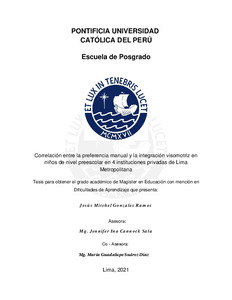Correlación entre la preferencia manual y la integración visomotriz en niños de nivel preescolar en 4 instituciones privadas de Lima Metropolitana
Abstract
El estudio tuvo por objetivo principal, determinar si es que la definición de la
Preferencia Manual influye en el desarrollo de la Integración Visomotriz,
específicamente en la capacidad de copiar figuras. La muestra estuvo constituida
por 233 niños (117 varones y 116 mujeres) de 4 instituciones privadas de
educación preescolar de la ciudad de Lima Metropolitana, el promedio de edad
fue de 3,71 años. La preferencia manual fue evaluada con el Edinburgh
Handedness Inventory (Oldfield, 1971) y la integración visomotriz fue evaluada
con el Beery-Buteknica Developmental Test of Visual-Motor Integration. Los
resultados no muestran relación de dependencia entre preferencia manual e
integración visomotriz, si consideramos la preferencia manual en las categorías de
definida e indefinida y la integración visomotriz en categorías de puntaje estándar
(7 categorías que van de muy bajo a muy alto). Sin embargo, al analizar el
cociente de preferencia manual (cantidad de ítems realizados con la misma mano)
y el puntaje bruto en la prueba de integración visomotriz (cantidad de ítems
completados correctamente), sí se obtiene una correlación positiva (muy baja);
esto significa que, en poca medida, un incremento en la proporción de uso de una
determinada mano produce un incremento en la cantidad de figuras copiadas
correctamente. The main objective of the study was to determine if the definition of Manual
Preference influences the development of Visual Motor Integration, specifically in
the ability to copy figures. The sample consisted of 233 children (117 males and
116 females) from 4 private institutions of pre-school education of the city of
Lima, the average age was 3.71 years. Handedness was assessed with the
Edinburgh Handedness Inventory (Oldfield, 1971) and visual-motor integration
was assessed with Beery Developmental Test-Buteknica of Visual-Motor
Integration. The results show no relationship of dependence between hand
preference and visual-motor integration, if we consider the manual preference in
the defined and undefined categories and the visual motor integration in standard
scoring categories (7 categories ranging from very low to very high). However,
when analyzing the hand preference quotient (number of items made with the
same hand) and the gross score in the visual motor integration test (number of
correctly completed items), a positive (very low) correlation is obtained; this
means that to a small extent, an increase in the proportion of use of a certain hand
produces an increase in the number of figures copied correctly.
Temas
Izquierda y derecha (Psicología)
Lateralidad (Fisiología)
Psicomotricidad
Educación preescolar--Investigaciones--Perú
Lateralidad (Fisiología)
Psicomotricidad
Educación preescolar--Investigaciones--Perú
Para optar el título de
Maestro en Educación con mención en Dificultades de Aprendizaje
The following license files are associated with this item:






